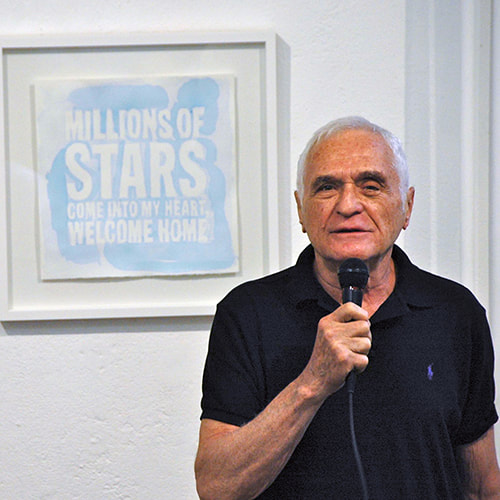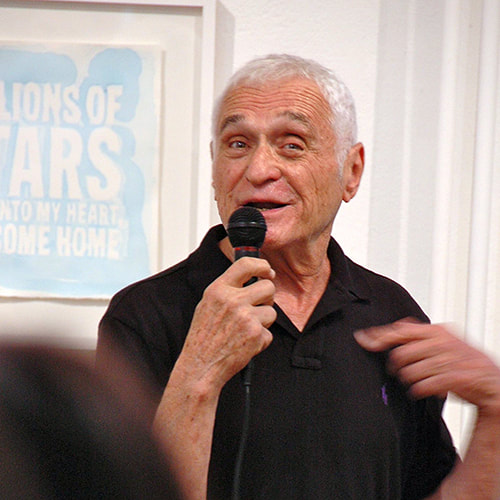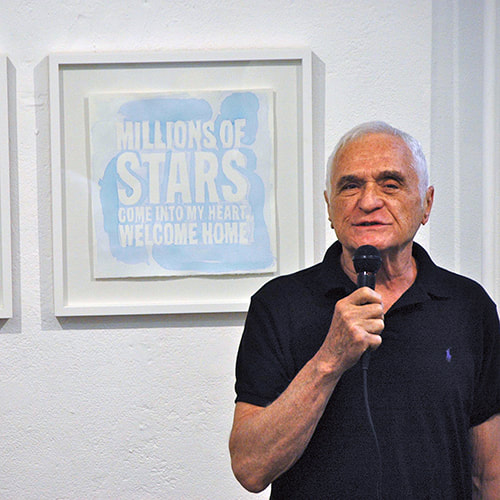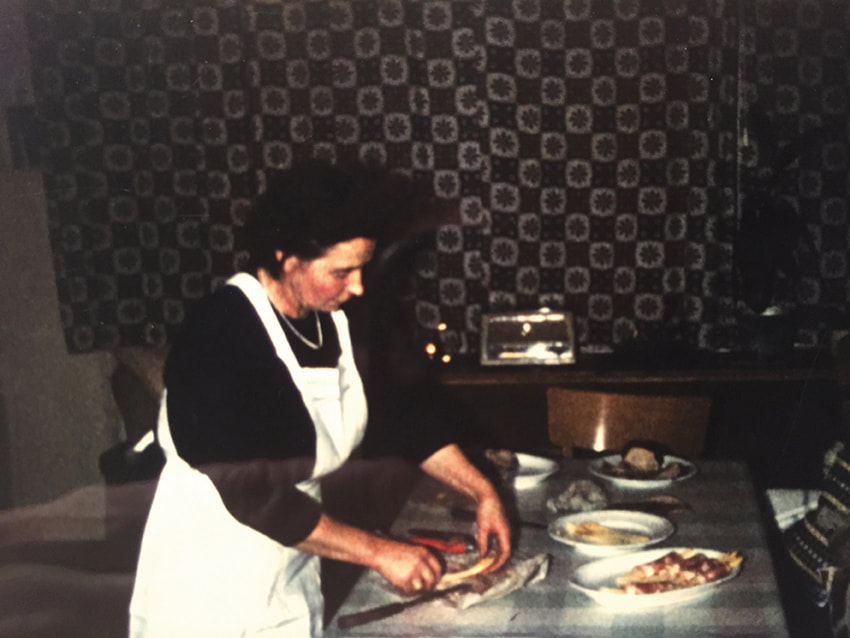|
11/3/2022 NO 4Being in the here and now Meeting and spending time with John Giorno was one of the highlights during my time as a gallerist, and remains a gift I deeply cherish. Besides John being a great artist and beat poet, he was a man full of stories directly connected to the many things I heard and read about when I was a teenager and young adult. As a teen I was an 80s hippie. As I aspired to become an artist, my cultural interests were rooted in ideas of the 60s, 70s and 80s. In 2012, my friend and cultural journalist Gaby Hartel connected me with John and proposed that I host a performance and exhibition in my gallery in Berlin. I met John in his loft in NYC. He welcomed me with his grand smile and sparkling eyes in his apartment, showed me his studio and also the basement, William Burrough’s bunker. We liked each other and agreed to a performance and an exhibition. In Berlin, I was living with my daughter and our dog Loui adjacent to the gallery, a 180 square meter large old Berlin apartment with 4,50-meter-high ceiling, directly in the heart of Berlin-Schöneberg. When John came, he stayed in the guestroom for several days. John was an avid Buddhist and meditated in between working on the drawings for the exhibition, having some coffee or tea with us in the morning and visiting friends. The exhibition was entitled YOU HAVE GOT TO BURN TO SHINE and consisted of 33 water color works on paper, all square and framed in a white, simple frame. That’s what he wanted and it was beautiful. The performance was a special gift, the exhibition a success. It was only natural to me, that after meeting John, I wanted to keep an artwork as a memory to this wonderful man and the time shared. As I often did, I gave my clients the right away, but kept an eye on I RESIGN MYSELF TO BEING HERE and decided to purchase it. I had moved back and forth, between San Francisco and Berlin, twice in my life. The cities are very different from each other, in vibes, in architecture, in culture, in nature, in life style. These differences are part of a variety in lifestyle and surroundings I seek, but it’s only now, that I understand this being a part of me. I used to compare, make one worse than the other, probably to not miss it too much. I switched them around, hunting after the place where the grass is always greener. What I had imagined San Francisco to be, turned into something else over the years, making me feel uprooted and like a constant visitor. I wanted to be back in Berlin, left and visited San Francisco and New York regularly. The social and cultural attachments in all places were significant, and for a time, I got to a point of feeling fragmented. I had to learn to train my thoughts, changing the constant comparisons of what’s missing, into appreciating both worlds and the abundance this lifestyle entails. Once you learn to listen to your thoughts, you also notice the self-degrading chatter. Meeting John had sparked the impulse to really go into depths of practicing things like ‘accepting the moment’, ‘being in the moment’, ‘accepting what is’…We so easily say it, but it’s difficult to be it. John emanated such a calm and loving presence, sincerely listening and paying attention to anybody, no matter who. I RESIGN MYSELF TO BEING HERE became an assisting tool to change my habitual thinking. The artwork is my visual mantra. I look at it consciously, when I feel I want to chase the greener grass, ignoring the one I’m standing on. It’s a reminder to count my blessings, to prioritize the important things in life, like love, respect for oneself and others, to appreciate. It's a reminder to be OK with confronting a challenge, a difficult time, because we know, all moments pass and new ones will come. John Giorno was one of the most loving, kind-hearted and accepting person I have met in my life. DO THE DEAD EAT?Somebody once told me “Food and grief are closely intertwined in many cultures.” Really? Hmm … I remember when struck with heavy grief, food was the last thing I thought about. Even when my siblings and I had to think about the funeral food for our parents, it was more about the space, where best to hold the funeral dinner. I also remember the sense of appetite being distorted. I didn’t think about it, neither did I feel hunger. Only as I sat down and ate something, I noticed that I was hungry. However, the need to cook for people who grief seems to be pervasive, as a helpful thing to do. Either way, it’s the time of the year to celebrate the dead and ancestry. Celebrations of remembrance and honoring seem to differ throughout the world: from gloomy walks to the cemetery and painful moments kneeing on hard benches in cold catholic churches in small towns in Germany, to the bright and colorful festivities of Mexico’s Dia de los Muertos. I wonder about the various food made served during rituals. Often, it is special food prepared for the occasion, served in dedicated vessels or leaves from a plant, or food used to represent something else. The Japanese Obon festival is directly related to the Chinese Ghost festival, a tradition Taoists and Buddhists celebrate in numerous East Asian countries. Ghosts and spirits, including those of deceased ancestors come out from other realms to visit and sometimes need guidance to not get lost, when traveling between the worlds. For example, during Obon, cucumbers and eggplants are transformed into vehicles for the ancestors to travel or ride back ride and forth. Simply by sticking wooden chopsticks in as legs, the cucumber becomes a spirit horse Shōryō-uma and the eggplant Shōryō-ushi a spirit cow. As a big Hayao Miyazaki fan, I’m reminded of the film Spirited Away, with the many always eating, never restless and unsatisfied ghosts, tormented by an insatiable hunger, constantly needed to be fed with tons and tons of foods.  @ Studio Ghibli/Miyazaki. The ghost "No-Face" (カオナシ kaonashi, lit. "Faceless") from Spirited Away, is able to react to emotions and ingests other individuals to gain their personality and physical traits. "Kaonashi is a metaphor, the libido that everybody secretly harbors." said by Miyazaki himself. No-Face is also a spirit of temptation. Suffering is caused by desire and the only way to avoid suffering is to deny desire. Pitru Paksha, a Hindu version, honors their ancestors through special food offerings, which must include dishes of sweet rice with milk, sweet porridge, rice, dal, spring bean and pumpkin, all served in silver or copper vessels and placed on banana leaves. When creating something dedicated to the memory of a person, someone you love and miss, it makes sense to choose sugar as an overall choice for taste. In Sardina, Su Mortu Mortu, is the celebration of the dead commenced on October 31st, our Halloween. Sweet baked goods are made and when setting the table, an extra table set is placed for the deceased, with the exception of forks and knives. I guess here is some suspicion left. I imagine cooking my parent's favorite meal. But would I eat it? My mother liked this canned meet stew called Ragout fin (French ragoût fin, "fine ragout"). It's a ragout served as an appetizer of classic German, especially Berlin cuisine, made of white meat and offal in a white sauce. Prepared from veal, sweetbreads, calf's brain, tongue, back marrow and chicken breast, depending on recipe sometimes fish, it is all cooked in light vinegar water or steamed in butter and cut into small cubes.Second ingredient is a white sauce made of light roux, broth, white wine, anchovies, lemon juice, cream and steamed mushrooms, alloyed with egg yolk. Cubes and sauce are mixed, heated in a bain-marie and then baked in cups, scallop shells or vol-au-vents (puff pastry molds) with breadcrumbs, cheese and butter. Ragout fin is subsequently seasoned to taste with worcestershire sauce and lemon juice. I mean, check out all the animal products in one single dish. (it reminds me again of Koanashi) ...no wonder, Berlin is the vegan capital of the world!!! When my father was younger, he loved pea and lentil soups, kale with potatoes and sausages, and his self-raised smoked trout. When aged, he loved potato latkes with a sweet turnip molasses (Rübenkraut) and Viennese Sacher Torte. I don’t remember my grandparent’s favorite food. But I do remember what my grandmother like to make (Quark cheese cake with sweet mandarines from a can), I think my grandpa loved to eat sausages with mustard. Food trends change, a bit like fashion. The dishes I remember from childhood seem to me a kind of “forgotten food”. But without cooking and eating dishes like Ragout fin, I guess I still honor my mother by remembering this. After all, times and circumstances our ancestors lived in, are also reflected in the food they ate and prepared. I share a recipe from my cookbook modern german food from a berlin kitchen, available as an Ebook here, remembering that this salad was served in lots of restaurants when I was a child. grated raw root vegetable salad |
|
|
Kit Schulte
Modern German Food
|














